Literature, Culture, Animal, Food, and Paintings (And male celebrities)
Don't wanna be here? Send us removal request.
Photo

Crystal jellies are clearly awesome!
Crystal jellies are very transparent about their life in the open ocean. The frilly mouth of the jelly—it’s the little clapper below the bell—can extend to nearly the size of the jelly itself to swallow food.

Here, you can see the mouth in action, moving along the bell edges to slurp food from the tentacles.

OH! And the “spokes on a wheel” of the crystal jelly are “radial canals”, which move nutrients about the jelly. The gonads run along these canals, and will look like white highlights about the “spokes” if the jelly is gravid.

youtube
630 notes
·
View notes
Text
I have transferred this whole blog safely over to a new home at 2mblr.com/mayamyst
You can view all my past posts and Follow me there!
0 notes
Photo

145 years ago, this drawing was done of real life for the cover of a popular publication. On one side, a rich family buying Christmas dinner. On the other side, a poor family. Not much changes, does it? :(
19 notes
·
View notes
Text
The Shogun Who Loved Dogs
Tsunayoshi Tokugawa was shogun of Japan from 1680 to 1709. For a long time, he had a bad reputation, historically. The samurai class disliked him because Tsunayoshi had a fondness for boys of any class – and the samurai did not like that Tsunayoshi did not discriminate his lovers by class. He was also a pretty strict ruler, confiscating many properties, cracking down on prostitution, and banning too-fancy fabrics. None of which likely endeared Tsunayoshi to the literate class, either. But this is not a post about his administrative style. This is a post about dogs.
Often fondly referred to as Oinusama (the dog shogun), Tsunayoshi really did have a soft spot for canines. He was born during the Year of the Dog, and was told that he had been a dog in a previous life. Tsunayoshi also issued a number of edicts, known as Edicts on Compassion for Living Things, that were released daily to the public. Most of them involved the protection of dogs — in fact, it was a capital crime to harm one. A massive kennel, said to have held more than 50,000 dogs, had to be set up outside the capital city of Edo to house the surfeit of dogs that resulted. Paid for by the happy citizens of Edo, of course.
Tsunayoshi was not just about the dogs, though that is what he remains known for. He became immersed in Neo-Confucianism and studied it profusely. Through this influence, Tsunayoshi enacted many protections for living beings — not just dogs — during his rule. In fact, he also insisted abandoned children and sick travelers should be taken care of and not be left to die, as was often the practice.
725 notes
·
View notes
Link
The newly named butterfly is known to scientists from only two male specimens. One has been held by the Smithsonian Natural History Museum since 1981, but for many years it languished in a drawer, forgotten.
125 notes
·
View notes
Link
Yo. I wrote a book and it is literally so dope and it would mean the world to me if you bought it for either yourself or for a friend this holiday season!

I’ve been out here answering your cephalopod questions for over 5 years now, so if you would be a pal, tell your friends about this book! It covers cephalopod anatomy, has a cephalopod for every letter and comes with facts about each one!
225 notes
·
View notes
Text
When Did Cats Arrive In Japan?
The domesticated cat may have arrived in Japan, via Korea, during the Nara period – that’s sometime between 710 and 794 CE. They were highly valued for their ability to kill rodents, and slowly became adopted as personal pets as well.
794 notes
·
View notes
Photo

Did you know that some species of starfish have the ability to regrow an a complete new central disc and body from a single arm?
More commonly in other starfish species, a severed limb will only be able to regenerate into a full-grown #starfish if it is already attached to at least a portion of the central disc of the animal.
#regeneration #stemcells #oceanfacts
492 notes
·
View notes
Text
10 Things: Calling All Pluto Lovers
June 22 marks the 40th anniversary of Charon’s discovery—the dwarf planet Pluto’s largest and first known moon. While the definition of a planet is the subject of vigorous scientific debate, this dwarf planet is a fascinating world to explore. Get to know Pluto’s beautiful, fascinating companion this week.
1. A Happy Accident
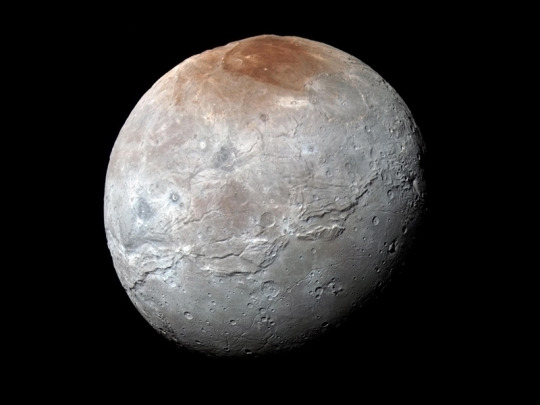
Astronomers James Christy and Robert Harrington weren’t even looking for satellites of Pluto when they discovered Charon in June 1978 at the U.S. Naval Observatory Flagstaff Station in Arizona – only about six miles from where Pluto was discovered at Lowell Observatory. Instead, they were trying to refine Pluto’s orbit around the Sun when sharp-eyed Christy noticed images of Pluto were strangely elongated; a blob seemed to move around Pluto.
The direction of elongation cycled back and forth over 6.39 days―the same as Pluto’s rotation period. Searching through their archives of Pluto images taken years before, Christy then found more cases where Pluto appeared elongated. Additional images confirmed he had discovered the first known moon of Pluto.
2. Forever and Always
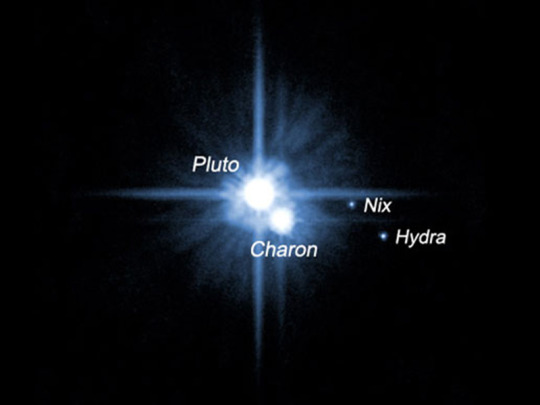
Christy proposed the name Charon after the mythological ferryman who carried souls across the river Acheron, one of the five mythical rivers that surrounded Pluto’s underworld. But Christy also chose it for a more personal reason: The first four letters matched the name of his wife, Charlene. (Cue the collective sigh.)
3. Big Little Moon
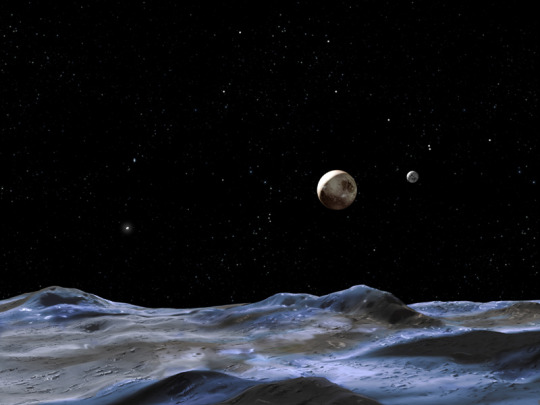
Charon—the largest of Pluto’s five moons and approximately the size of Texas—is almost half the size of Pluto itself. The little moon is so big that Pluto and Charon are sometimes referred to as a double dwarf planet system. The distance between them is 12,200 miles (19,640 kilometers).
4. A Colorful and Violent History
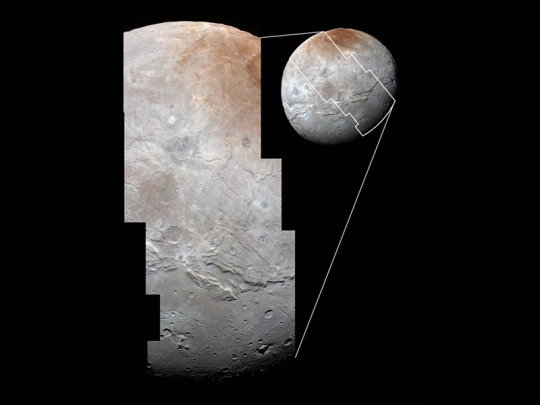
Many scientists on the New Horizons mission expected Charon to be a monotonous, crater-battered world; instead, they found a landscape covered with mountains, canyons, landslides, surface-color variations and more. High-resolution images of the Pluto-facing hemisphere of Charon, taken by New Horizons as the spacecraft sped through the Pluto system on July 14 and transmitted to Earth on Sept. 21, reveal details of a belt of fractures and canyons just north of the moon’s equator.
5. Grander Canyon

This great canyon system stretches more than 1,000 miles (1,600 kilometers) across the entire face of Charon and likely around onto Charon’s far side. Four times as long as the Grand Canyon, and twice as deep in places, these faults and canyons indicate a titanic geological upheaval in Charon’s past.
6. Officially Official
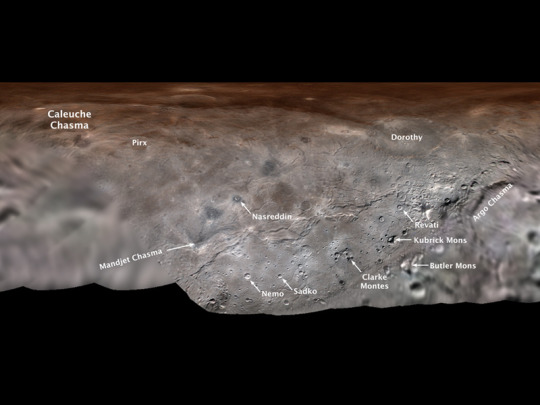
In April 2018, the International Astronomical Union—the internationally recognized authority for naming celestial bodies and their surface features—approved a dozen names for Charon’s features proposed by our New Horizons mission team. Many of the names focus on the literature and mythology of exploration.
7. Flying Over Charon
youtube
This flyover video of Charon was created thanks to images from our New Horizons spacecraft. The “flight” starts with the informally named Mordor (dark) region near Charon’s north pole. Then the camera moves south to a vast chasm, descending to just 40 miles (60 kilometers) above the surface to fly through the canyon system.
8. Strikingly Different Worlds
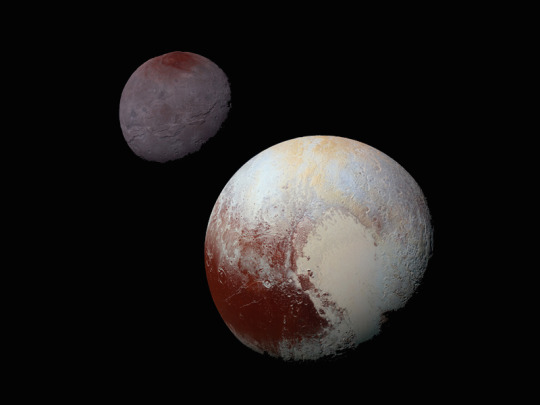
This composite of enhanced color images of Pluto (lower right) and Charon (upper left), was taken by New Horizons as it passed through the Pluto system on July 14, 2015. This image highlights the striking differences between Pluto and Charon. The color and brightness of both Pluto and Charon have been processed identically to allow direct comparison of their surface properties, and to highlight the similarity between Charon’s polar red terrain and Pluto’s equatorial red terrain.
9. Quality Facetime

Charon neither rises nor sets, but hovers over the same spot on Pluto’s surface, and the same side of Charon always faces Pluto―a phenomenon called mutual tidal locking.
10. Shine On, Charon
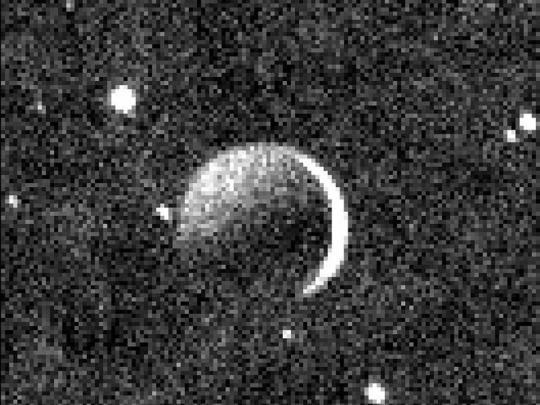
Bathed in “Plutoshine,” this image from New Horizons shows the night side of Charon against a star field lit by faint, reflected light from Pluto itself on July 15, 2015.
Read the full version of this week’s ‘10 Things to Know’ article on the web HERE.
Make sure to follow us on Tumblr for your regular dose of space: http://nasa.tumblr.com.
3K notes
·
View notes









